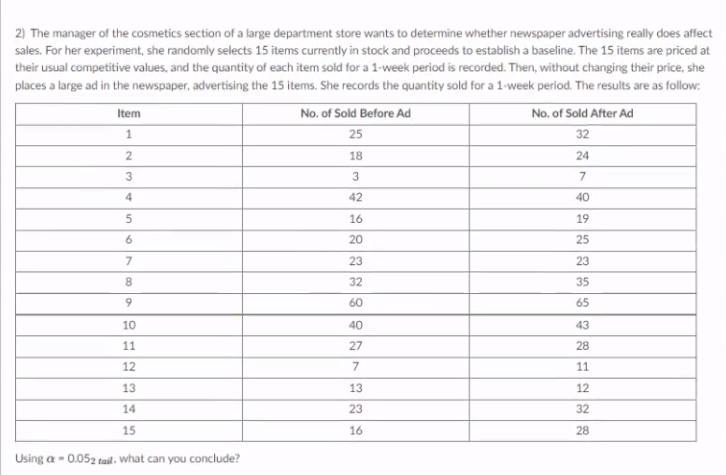2) The manager of the cosmetics section of a large department store wants to determine whether newspaper advertising really does affect sales. For her experiment, she randomly selects 15 items currently in stock and proceeds to establish a baseline. The 15 items are priced at their usual competitive values, and the quantity of each item sold for a 1-week period is recorded. Then, without changing their price, she places a large ad in the newspaper, advertising the 15 items. She records the quantity sold for a 1-week period. The results are as follow: Item No. of Sold Before Ad No. of Sold After Ad 25 32 18 24 3 4 42 40 16 19 6. 20 25 7. 23 23 32 35 60 65 10 40 43 11 27 28 12 11 13 13 12 14 23 32 15 16 28 Using a - 0.052 tail, what can you conclude?
2) The manager of the cosmetics section of a large department store wants to determine whether newspaper advertising really does affect sales. For her experiment, she randomly selects 15 items currently in stock and proceeds to establish a baseline. The 15 items are priced at their usual competitive values, and the quantity of each item sold for a 1-week period is recorded. Then, without changing their price, she places a large ad in the newspaper, advertising the 15 items. She records the quantity sold for a 1-week period. The results are as follow: Item No. of Sold Before Ad No. of Sold After Ad 25 32 18 24 3 4 42 40 16 19 6. 20 25 7. 23 23 32 35 60 65 10 40 43 11 27 28 12 11 13 13 12 14 23 32 15 16 28 Using a - 0.052 tail, what can you conclude?
Glencoe Algebra 1, Student Edition, 9780079039897, 0079039898, 2018
18th Edition
ISBN:9780079039897
Author:Carter
Publisher:Carter
Chapter10: Statistics
Section10.6: Summarizing Categorical Data
Problem 27PPS
Related questions
Question

Transcribed Image Text:2) The manager of the cosmetics section of a large department store wants to determine whether newspaper advertising really does affect
sales. For her experiment, she randomly selects 15 items currently in stock and proceeds to establish a baseline. The 15 items are priced at
their usual competitive values, and the quantity of each item sold for a 1-week period is recorded. Then, without changing their price, she
places a large ad in the newspaper, advertising the 15 items. She records the quantity sold for a 1-week period. The results are as follow:
Item
No. of Sold Before Ad
No. of Sold After Ad
1.
25
32
18
24
3
7
4
42
40
16
19
6.
20
25
7
23
23
32
35
60
65
10
40
43
11
27
28
12
7
11
13
13
12
14
23
32
15
16
28
Using a - 0.052 tail , what can you conclude?
Expert Solution
This question has been solved!
Explore an expertly crafted, step-by-step solution for a thorough understanding of key concepts.
This is a popular solution!
Trending now
This is a popular solution!
Step by step
Solved in 2 steps with 1 images

Recommended textbooks for you

Glencoe Algebra 1, Student Edition, 9780079039897…
Algebra
ISBN:
9780079039897
Author:
Carter
Publisher:
McGraw Hill

Glencoe Algebra 1, Student Edition, 9780079039897…
Algebra
ISBN:
9780079039897
Author:
Carter
Publisher:
McGraw Hill